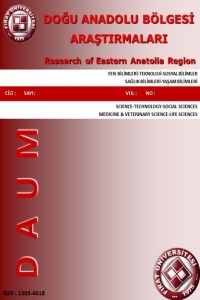TAVUS KELEBEĞİ, Inachis io (L.), (LEPIDOPTERA: NYMPHALIDAE) LARVALARININ BESİN TERCİHİNE ETKİ EDEN KİMYASAL FAKTÖRLER
Inachis io, Urtica dioica, Protein Miktarı, Su Miktarı, Toplam Fenolik Miktarı
THE CHEMICAL FACTORS INFLUENCING ON THE FOOD CHOICE OF PEACOCK, Inachis io (L.), (LEPIDOPTERA:NYMPHALIDAE)
Inachis io, Urtica dioica, Protein Content, Water Content, Total Phenolic Content,
___
- 1. Allen, S. E., Grimshaw, H. M., Parkinson, J. A., Quarmby, C. and Roberts, J. D., 1986. Chemical Analysis. In: Champman, S. B. (eds) Methods in Plant Ecology, pp. 411-466. Blackwell Scientific Publications, Oxford.
- 2. Bilgener, M. ve Uysal, S., 1996. Ölübaş Kele-beği Celerio euphorbiae L. (Lepidoptera: Sphingidae)'nin Besin Sindirim Verimliliği. Doğa Türk Biyoloji Dergisi, 20: 273-280.
- 3. Bryant, S. R., Thomas, C. D. and Bale, J. B., 1997. Nettle Nymphalid Butterflies: Tempera-ture, development and distribution. Ecological Entomology, 22: 390-398.
- 4. Feeny, P., 1968. Seasonal changes in the tannin content of oak leaves. Phytochemistry, 7, 871-880.
- 5. Fox, LR, Morrow, PA., 1981. Specialization: Species property or local phenomenon? Scien-ce, 211, 887-892.
- 6. Harborne, J. B., 1994. Introduction to Ecologi-cal Biochemistry. Academic Press (Çeviri: Bilgener, M., 2002. Ekolojik Biyokimyaya Gi-riş, sayfa 126.Ondokuzmayıs Üniversitesi Ya-yınları. Samsun).
- 7. Jones, D. A. 1966. On the polymorphism of cyanogenesis in Lotus corniculatus. I. Selection by animals. Can. J. Genet. Cytol. 8:556–567. 8. Mattson, J. , 1980. Herbivory in relation to plant nitrogen content. Ann. Rev. Ecol. Syst., 11, 119-161.
- 9. Morrison, I. M., (1972a). A semi-micro method for the determination of lignin and its use in predicting digestibility of forage crops. J. Sci. Food Agric., 23, 455-463.
- 10. Morrison, I. M., (1972b). Improvements in the acetyl bromide technique to determine lignin and digestibility and its application to legumes. J. Sci. Food Agric., 23, 1463-1469.
- 11. Pollard, A. J. and Briggs, D., 1984. Genecolo-gical studies of Urtica dioica L. III. Stinging Hairs and Plant- Herbivore Interactions. New Phytologist, 97, 507-522.
- 12. Pullin, A. S., 1986. Influence of the food plant, Urtica dioica, on larval development, feeding efficiences, and voltinism of a specialist insect, Inachis io. Holarctic Ecology, 9, 72-78.
- 13. Scriber, J. M., 1977. Limiting effects of low leaf-water content on the nitrogen utilization, energy budget, and larval growth of Hyalophora cecropia (Lepidoptera: Saturniidae). Oecologia 28, 269-287.
- 14. Scriber, J. M. and Feeny, P. P., 1979. The growth of herbivorous caterpillars in relation to degree of feeding specialization and to growth form of foodplant. Ecology, 60, 829-850.
- 15. Scriber, J.M. and Slansky, F.,Jr. 1981. The nutritional ecology of immature insects. A. Rev. Ent., 26, 183-211.
- 16. Simpson S. J. and D. Raubenheimer 2001. The geometric analysis of nutrientalleloche-mical interactions: a case study using locusts. Ecology 82, pp. 422-439.
- 17. Slansky, F. Jr., Feeny, P., 1977. Stabilization of the rate of nitrogen accumulation by larvae of the cabbage butterfly on wild and cultivated plants. Ecol. Monogr. 47, 209-228.
- 18. Smiley, J., 1978. Plant Chemistry and the Evolution of Host Specifity: New Evidence from Heliconius and Passiflora. Science, 201, 745-747.
- 19. Swain, T. and Hillis, W. E., 1959. The phe-nolic constituents of Prunus domestica. J. Sci. Food Agric., 10, 63-68.
- ISSN: 1303-4618
- Başlangıç: 2002
- Yayıncı: Fırat Üniversitesi
SON DEĞERLENDİRMELER IŞIĞINDA KEBAN BARAJI’NIN ELAZIĞ İKLİMİNE ETKİSİ
ÖĞRETMEN ADAYLARIN KULLANDIKLARI YABANCI DİL ÖĞRENME STRATEJİLERİ
YENİLENEBİLİR BİR ENERJİ KAYNAĞI: BİYOGAZ
ELAZIĞ’DA SOSYAL BİR KALKINMA HAMLESİ: GİRİŞİMCİLİK EĞİTİM KURSU
Beyzade Nadir ÇETİN, Ali Sirri YILMAZ
Başar ALTINTERİM, Mustafa DÖRÜCÜ
SARIM TEKNİKLERİ EĞİTİMİ İÇİN BİR BENZETİM PROGRAMI
WEB TABANLI ONLİNE SINAV SİSTEMİ
PUBERTE DÖNEMİ HENTBOL VE BASKETBOLCULARIN BİOMOTOR ÖZELLİKLERİNİN KARŞILAŞTIRILMASI
Tarik DEMİREL, Yakup Akif AFYON, Hüseyin ÖZKAN
